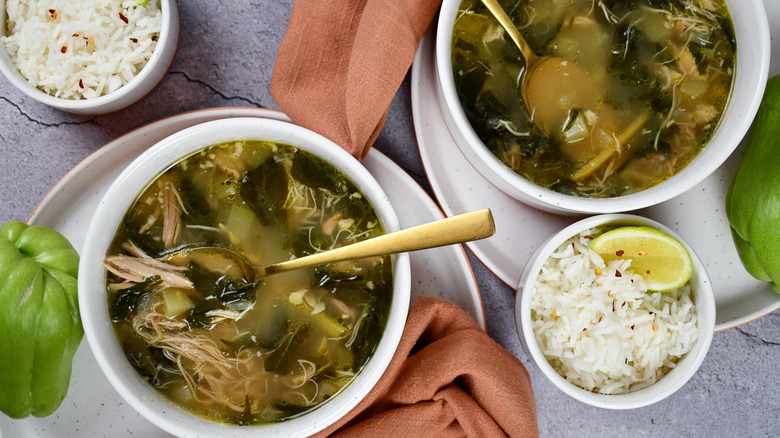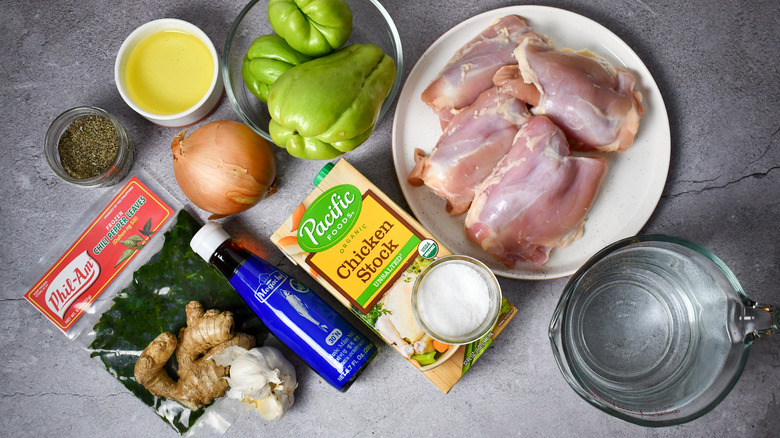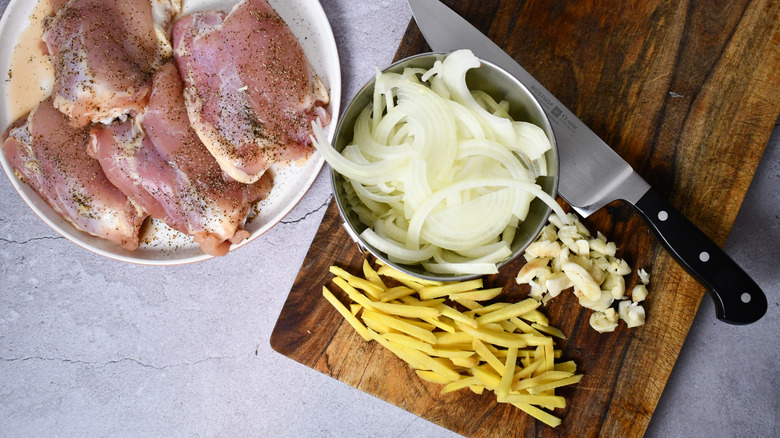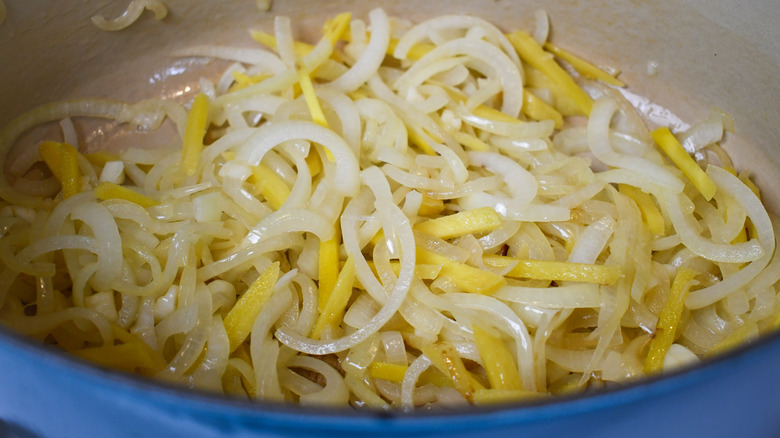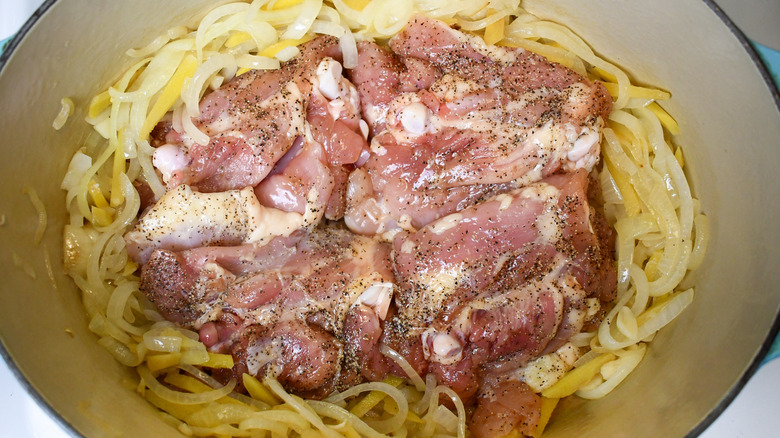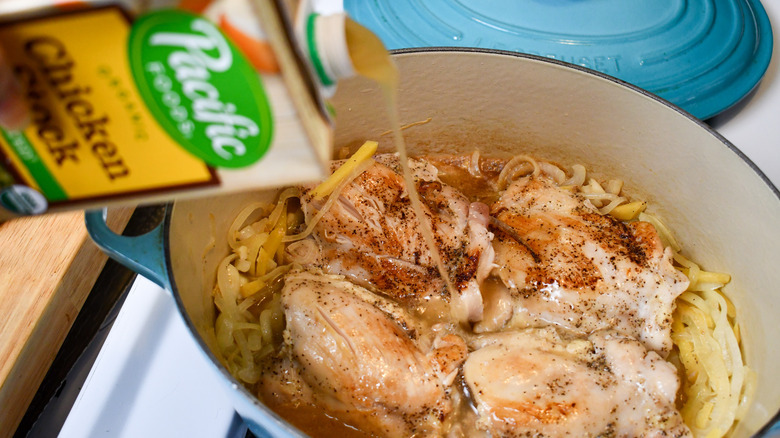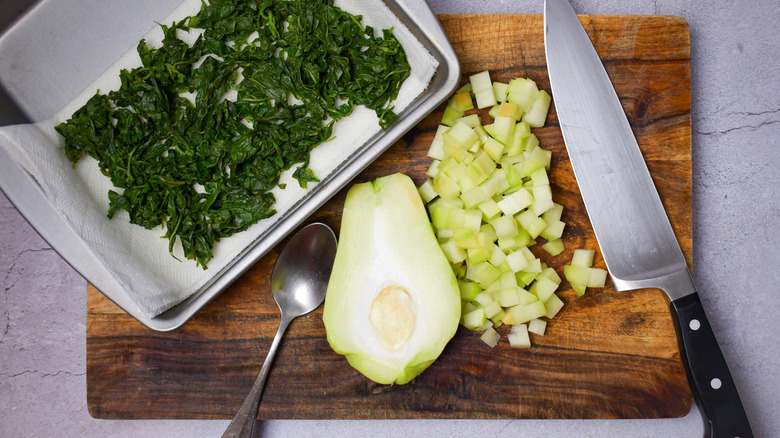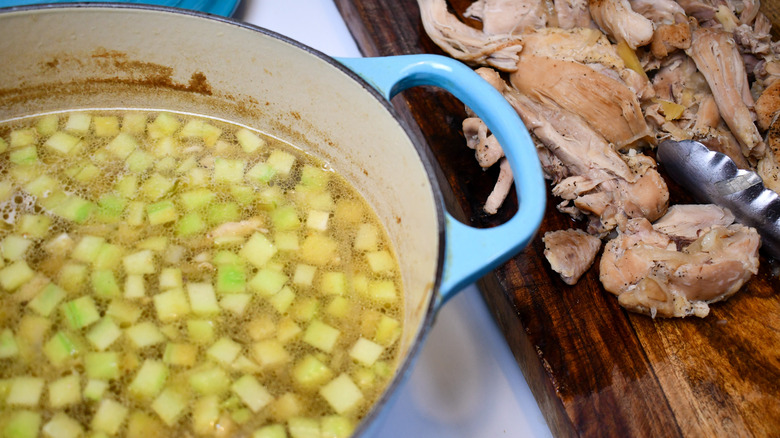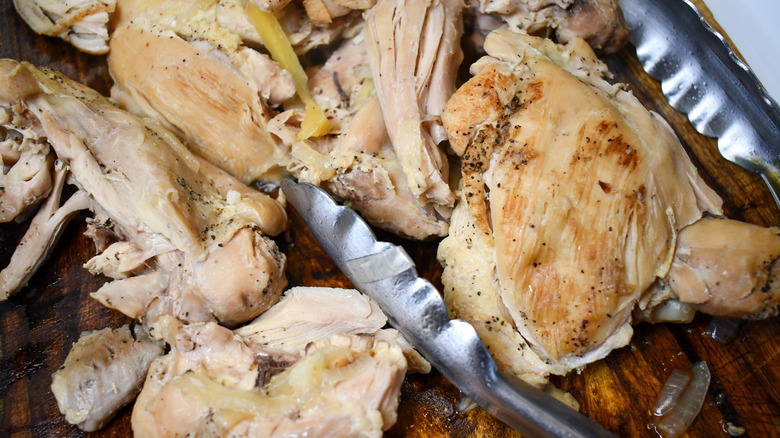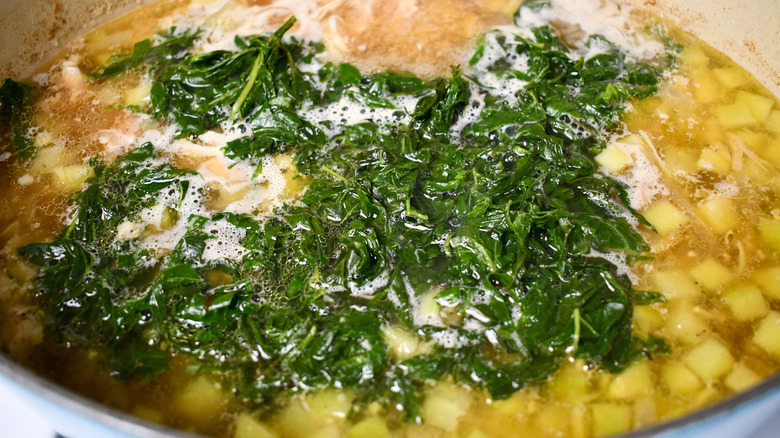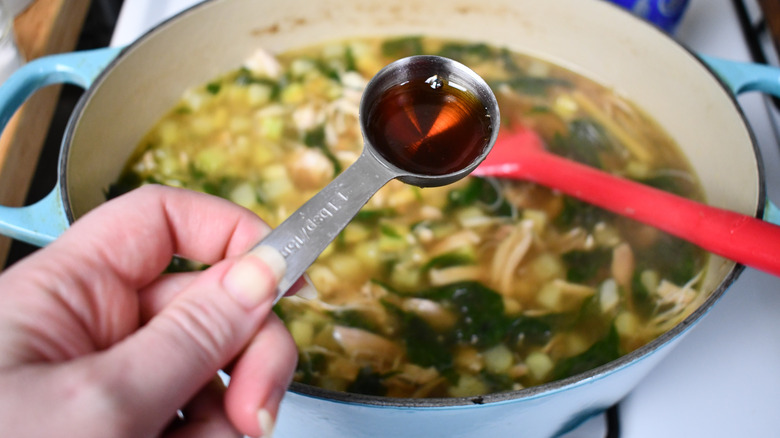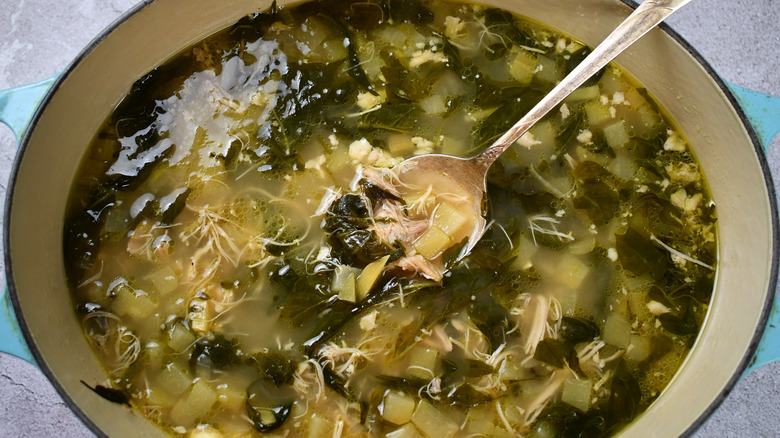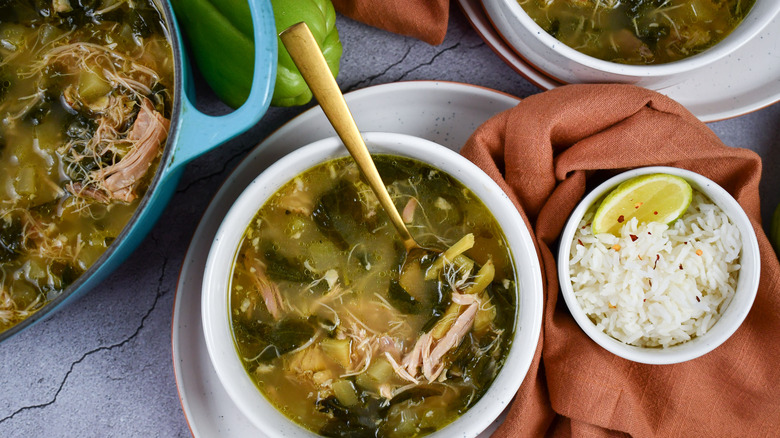Chicken Tinola (Tinolang Manok) Recipe
Chicken tinola is a classic Filipino soup, known for its rich chicken broth spiced with fresh ginger and studded with chayote squash. The comforting dish, called tinolang manok in Filipino, is also fortified with leafy greens and fish sauce for additional depth of flavor.
Recipe developer Jenny Kellerhals set out to prepare this satisfying soup at home, with guidance from Diana Manalang, chef and owner of Little Chef Cafe in Long Island City, Queens, NYC, and Cj Barroso, executive chef at The Thorn in Thornwood, NY. While chicken tinola is the perfect dish when you're feeling under the weather or when it's cold outside, it can be enjoyed anytime. "[A]s a Filipino-American, I was raised to eat soups and stews throughout the year — not just during winter," says Manalang. "I eat this soup all year long. I believe it's why I hardly ever had a cold growing up."
"One of the first recipes I've made is tinola," says Barroso. "My aunt used to cook for us, and I would watch her and started helping out." He was so young when he started cooking his aunt's recipe that he had to stand on a stool to reach the pot. Manalang also learned to cook chicken tinola at home. "My mother is an excellent cook, and this was part of her rotation of dishes," she shares. Here's how you can make this comforting and warmly spiced soup yourself, for a satisfying meal at home.
Gather the ingredients for chicken tinola
This recipe comes together easily, but collect all of the ingredients ahead of time to make sure the cooking process goes smoothly. Gather the vegetable oil, chicken thighs, salt, pepper, onion, garlic cloves, ginger, chicken stock, water, chayote squash, chili pepper leaves, and fish sauce before you begin cooking.
If your chili pepper leaves were previously frozen, be sure to thaw them out before cooking. One 8-ounce bag of frozen leaves from the market contains ½ cup of leaves as needed for this recipe. Additionally, you will need a cutting board, peeler, knife, spoon, paper towels, liquid measuring cup, and measuring spoons to prepare and scale the ingredients. To cook the soup, you'll need a heavy-bottomed pot that holds 5 quarts or more, a silicone spatula, and tongs.
Prepare the chicken and vegetables
If you prefer to cook your chicken thighs without the skin, remove it first. Then, generously season both sides of the thighs with salt and pepper. Set them aside while you prepare the vegetables. Peel and halve the onion, then thinly slice each half. Peel the ginger and cut it into matchstick-like slivers. Peel and smash the garlic cloves, then roughly chop them into smaller pieces.
"Since my mother used to make this when I was sick — she would up the ginger," says Manalang. "So I like that nice bold punch of flavor." Three knobs of ginger is a relatively conservative amount of ginger, ideal for those who prefer a more subtle flavor. Add more if you want an extra kick from the ginger.
Sweat the vegetables
Heat the vegetable oil in the pot over medium-high heat. Add the onion, garlic, and ginger, and cook for about 3 minutes. Stir the vegetables often, cooking evenly until the onion slices become translucent and tender and the garlic is fragrant. Once tender but not browned, push the aromatic vegetables to the outside edges of the pot, leaving a well in the center to cook the chicken.
Brown the chicken thighs
Place the chicken thighs skin-side down, nestled into the center of the vegetables. Sear the thighs for about 5 minutes, allowing the chicken to brown and develop flavor. With tongs, turn the chicken thighs over and measure out the chicken stock and water for the next step.
Add stock and water to cook the soup
Immediately after flipping the chicken thighs, pour a quart of stock and a quart of water into the pot. Ensure that the chicken and ingredients are covered, adding more water if necessary. Bring the liquid to a boil, then reduce the heat to a simmer. Allow the soup to simmer for 30 minutes, or until the chicken is tender enough to easily pull away from the bone.
Prepare the chili pepper leaves and chayote squash
Strain the water from the chili pepper leaves and spread them across a paper towel to continue to drain. Peel the chayote squash, cut it in half lengthwise, and remove the soft seed and pithy core with a spoon. Cube the squash and reserve it for the next step.
Check the chicken and cook the chayote
After 30 minutes, check the chicken to see if it pulls away easily from the bone. You can either pull the meat into large chunks with the tongs and leave the bones in the soup, or remove the chicken thighs from the pot to break them down on a cutting board.
Once the chicken is cooked, add the cubed chayote squash to cook for 10 minutes until slightly tender. According to Manalang, the longer the chayote sits in the broth the better it tastes, "I especially like when the cyote/chayote sits in the broth and sops up all the yummy chicken and ginger flavor," she describes.
Optional: Shred the chicken and remove the bones
The cooked chicken thighs should be cool enough to handle after they've been out of the pot for about 5 minutes. Pull the meat from the bones and shred or chop the cooked chicken. Return the meat to the pot and discard the bones. Make sure to wash your hands before and after handling the chicken.
Add the chili pepper leaves
Once the chayote squash has simmered for about 10 minutes and the chicken is back in the pot, stir the chili pepper leaves into the soup. Cook for 2 more minutes to warm the ingredients all the way through.
Add fish sauce and final seasoning
Add a tablespoon of fish sauce and about a tablespoon of kosher salt to the soup and stir to combine the flavors. "Don't skip the fish sauce," says Manalang. "That burst of umami brings the broth up several notches." Taste the soup and add more seasoning as desired.
Serve immediately or cool and store for up to a week in the refrigerator. "It tastes great even when it's not heated to boiling," says Manalang, "and it freezes really well."
A note on ingredients
Various greens can be used for this dish depending on what is available. We found frozen chili pepper leaves at a local Filipino market in NYC, and you might be able to find them at Asian grocery stores and specialty food shops. "There's an herb called malunggay aka moringa" that tastes great in the soup, Barroso explains.
Manalang also suggests moringa leaves if you have access to them, as well as water spinach (also commonly called kangkong in the Philippines). Western versions of the dish sometimes substitute frozen spinach or blanched fresh spinach leaves, although water spinach is actually a different plant entirely, more closely related to the morning glory plant (via World Crops). If chili pepper leaves, moringa, or water spinach are unavailable, Manalang also recommends using bok choy.
For those who like their soup especially spicy, Manalang notes that you can add more ginger, but she's also a fan of adding chilis for a real fiery kick. On the other hand, if your soup ends up spicier than you'd like it to be, Manalang recommends adding "more chicken broth and a squeeze of lemon" to cut the heat.
This recipe calls for chicken thighs, but that's also flexible. Both Manalang and Barroso recommend using bone-in chicken, which can include drumsticks or even an entire chicken broken down into pieces. Finally, chayote squash is readily available in many grocery stores these days, but you can also substitute green papaya if you can't find it.
Serve the chicken tinola hot
Chicken tinola is deeply satisfying straight out of the pot, but it doesn't have to be served on its own. "Anything with broth or sauce is always eaten with rice," says Manalang, and Barroso agrees. "Rice all the way for Filipinos," he says.
"I also like to add a squeeze of lemon or lime," says Manalang. "That acid really brings it all in for me." Add freshly squeezed lemon or lime juice directly to the soup while seasoning, or serve citrus wedges on the side.
Chicken Tinola (Tinolang Manok) Recipe
Chicken tinola is a rich brothy chicken soup from the Philippines. It packs in plenty of flavor and is perfect whether you're feeling sick or in top health.
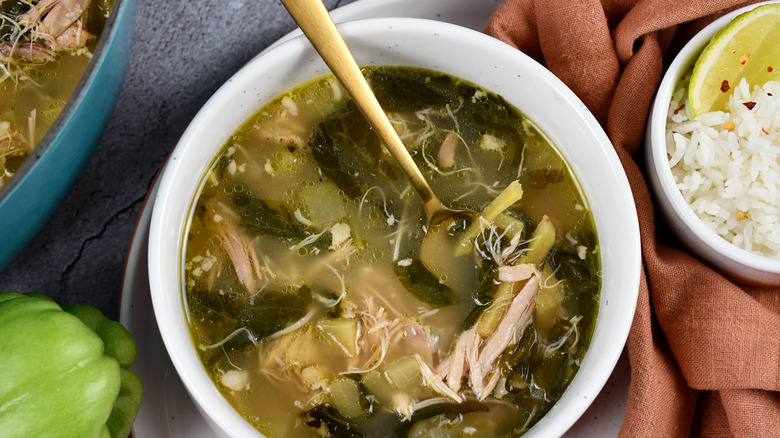
Ingredients
- 1 ½ tablespoons vegetable oil
- 2 ½ pounds chicken thighs, bone-in (with or without skin)
- kosher salt, to taste
- freshly ground black pepper, to taste
- 1 medium Spanish onion
- 4 large cloves garlic
- 3 knobs ginger
- 1 quart chicken stock, low or no sodium
- 1 quart water
- 1 chayote squash
- ½ cup chili pepper leaves, thawed if frozen
- 1 tablespoon fish sauce, plus more to taste
Optional Ingredients
- lime wedges, to garnish
- cooked white rice, to serve
Directions
- Generously salt and pepper the chicken thighs on both sides and set aside.
- Peel, halve, and thinly slice the onion.
- Peel, smash, and roughly chop the garlic cloves.
- Peel and slice the ginger knobs into matchsticks.
- In a 6-quart heavy-bottomed pot, heat the oil over medium-high heat.
- Add the onion, garlic, and ginger and cook for about 3 minutes as you stir to sweat (avoid caramelizing).
- Push the aromatics to the perimeter of the pot and nestle the chicken thighs in the center, skin-side down (even if you've removed the skin).
- Cook for 5 minutes, or until the chicken begins to brown.
- Flip the chicken thighs and add the chicken stock and water to the pot. (Add more water if needed to cover the chicken entirely.)
- Bring the contents to a boil, then reduce the heat to a simmer and cook for 30 minutes.
- If the chili leaves were frozen, drain the thawed leaves on paper towels.
- Peel and halve the chayote, then remove the seed and pithy center and cube the flesh.
- After 30 minutes, check if the chicken is tender enough to easily pull off the bone. Continue to cook, if needed.
- If you want to debone and shred the meat, use tongs to remove it from the soup and set it aside to cool.
- Add the cubed chayote to the pot and cook for 10 minutes.
- Once the chicken is cool enough, discard the bones, shred the cooked meat, and return it to the pot.
- After simmering the chayote for 10 minutes, add the pepper leaves and cook for 2 more minutes to warm through.
- Add the fish sauce and season with salt and pepper to taste.
- Serve immediately or cool to room temperature before chilling.
- Store the soup in an airtight container in the refrigerator for up to 5 days, or in the freezer for up to 3 months.
Nutrition
| Calories per Serving | 836 |
| Total Fat | 55.8 g |
| Saturated Fat | 14.1 g |
| Trans Fat | 0.3 g |
| Cholesterol | 285.0 mg |
| Total Carbohydrates | 26.5 g |
| Dietary Fiber | 3.5 g |
| Total Sugars | 7.3 g |
| Sodium | 2,125.4 mg |
| Protein | 55.5 g |
